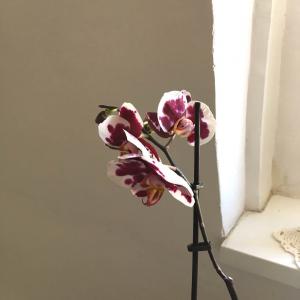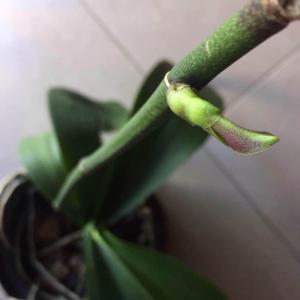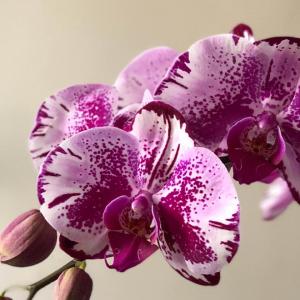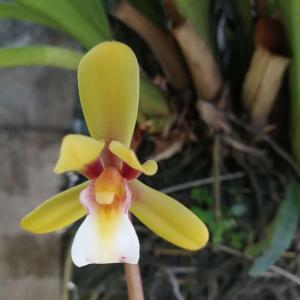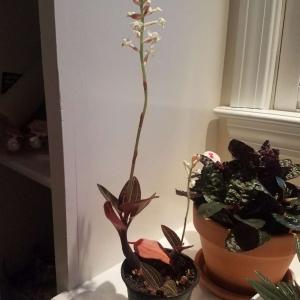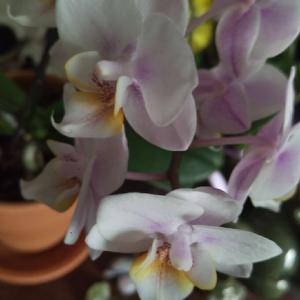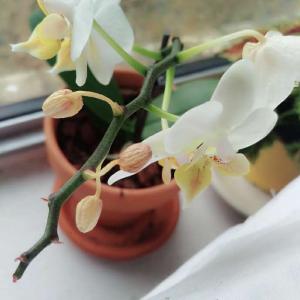成长记
kensong
2018年05月12日

Went for a two week vacation and left this moth orchid in my office to be cared for. Came back to this 😥




1
0
shirly mei:The leaves still look pretty healthy. my flowers has all died now too. Just cut the spike cuz it's all brown and wait for another one to grow
meriunkat:That's why I don't trust anyone else with my plants 😅
文章
Miss Chen
2018年05月08日

Description: This perennial orchid is 1–2½' tall and usually unbranched. The central stem is round in circumference, rather stout, and densely covered with hair. Three or more leaves alternate along this stem. These leaves are up to 6" long and 4" across; they are oval-ovate to ovate, smooth along their margins, and pubescent. Parallel veins are readily observable along the upper surface of each leaf. The base of each leaf clasps the stem. The color of the foliage can vary from dark green to yellowish green, depending on growing conditions and the maturity of the plant. The central stem terminates in 1 or 2 flowers. Each flower is held above the foliage on a long stalk that has a single leafy bract behind the flower. This bract resembles the leaves, but it is smaller in size and lanceolate in shape. Like other orchids, each flower has 3 petals and 3 sepals. However, because two of these sepals are fused together, there appears to be only 2 sepals.
The lower petal is in the shape of a slipper or a pouch with an opening on top; it is bright yellow, shiny, and 1½–2" in length. Within the interior of this petal, there are frequently reddish brown dots. The 2 lateral petals are very narrow, more or less twisted, and 2–3½" in length. These 2 petals vary in color from greenish yellow to brownish purple and they have fine veins running from their bases to their tips. The sepals form an upper hood and a lower hood. They are broader and shorter than the lateral petals, otherwise their appearance is similar. Both the lateral petals and sepals are more or less pubescent. The reproductive organs are located toward the posterior of the slipper-like lower petal. The blooming period occurs from late spring to early summer and lasts about 3 weeks. There is usually no noticeable floral scent. If a flower is successfully pollinated by insects (often this doesn't occur), it will form a seedpod. When this seedpod splits open, the fine seeds are easily carried aloft by the wind. The root system consists of a tuft of fleshy fibrous roots. When several plants occur together, they are often clonal offsets of the mother plant.

Cultivation: The preference is partial sun to light shade, moist to slightly dry conditions, and a soil that consists of loam or sandy loam. Young plants require the presence of appropriate endomycorrhizal fungi in the soil in order to flourish. Starting plants from seed is the job of an expert, although it is possible to successfully transplant large plants that have been grown in a greenhouse. This is one of the easier orchids to maintain in a flower garden.
Range & Habitat: The native Yellow Lady's Slipper is an uncommon plant that is widely scattered across Illinois (see Distribution Map). It is less common than formerly, but still persists in colonies of variable size at several sites. Habitats include moist to dry deciduous woodlands, sandy woodlands and savannas, thinly wooded bluffs along rivers, wooded slopes, and forested bogs. The size of local populations can increase in response to fallen trees from windstorms, or occasional wildfires, as this reduces excessive shade from woody vegetation. Some authorities regard this orchid as a native variety of Cypripedium calceolus, which occurs in Eurasia. Under this system of classification, its scientific name is Cypripedium calceolus pubescens.

Faunal Associations: The showy flowers attract mostly small bees and various flies. In North America, Robertson (1929) and Stoutamire (1967) observed honeybees, little carpenter bees (Ceratina spp.), mason bees (Osmia spp.), Halictid bees (Agapostemon sp., Lasioglossum spp.), and Andrenid bees (Andrena spp.) visiting the flowers. Some of these bees were regarded as effective at cross-pollination of the flowers, while other bees became trapped in the flowers and died. Miscellaneous flies and beetles were also observed to visit the flowers, but they were regarded as ineffective pollinators. The showy flowers are deceptive because they induce insects to explore the flowers in the expectation of a reward, but they contain no nectar and their pollen is unavailable to them. Two insects have been observed to feed on the Yellow Lady's Slipper Orchid: adults and larvae of a weevil (Stethobaris ovata) and larvae of a Scathophagid fly (Parallelomma vittatum). Adults of this weevil feed on the shoots, buds, and flowers, while its larvae feed within the seedpods of this orchid. Larvae of the preceding fly are leaf-miners. White-tailed Deer readily consume the foliage of this and other orchids, and local populations may require a deer-resistant fence for protection where these animals are abundant.
Photographic Location: The slope of a wooded bluff in Vermilion County, Illinois.

Comments: This is one of the largest and most attractive orchids in Illinois. It is more abundant than most species of orchid, although by no means common. While the flowers are in bloom, it is easy to identify this plant as a Cypripedium sp. (Lady's Slipper Orchid) because of the slipper-like lower petals. The only other species that it can be confused with, Cypripedium parviflorum (Small Yellow Lady's Slipper), has similar flowers that are smaller in size. The lateral petals of its flowers are less than 2" long, while the slipper-like lower petal is about ¾–1¼" in length. The flowers of this species are more likely to be fragrant. The Small Yellow Lady's Slipper usually has a pair of leaves toward the base of the central stem, while Yellow Lady's Slipper usually has 3-5 leaves along the central stem. Some authorities classify the Yellow Lady's Slipper as a variety of the Small Yellow Lady's Slipper, or Cypripedium parviflorum pubescens, rather than a distinct species. Regardless of its classification, when this orchid is not in bloom, it can superficially resemble Polygonatum commutatum (Solomon's Seal) and similar species in the Lily family. However, the central stem of this orchid and the upper surfaces of its leaves are pubescent, while the latter plants have stems and upper leaf surfaces that are waxy and glabrous.
The lower petal is in the shape of a slipper or a pouch with an opening on top; it is bright yellow, shiny, and 1½–2" in length. Within the interior of this petal, there are frequently reddish brown dots. The 2 lateral petals are very narrow, more or less twisted, and 2–3½" in length. These 2 petals vary in color from greenish yellow to brownish purple and they have fine veins running from their bases to their tips. The sepals form an upper hood and a lower hood. They are broader and shorter than the lateral petals, otherwise their appearance is similar. Both the lateral petals and sepals are more or less pubescent. The reproductive organs are located toward the posterior of the slipper-like lower petal. The blooming period occurs from late spring to early summer and lasts about 3 weeks. There is usually no noticeable floral scent. If a flower is successfully pollinated by insects (often this doesn't occur), it will form a seedpod. When this seedpod splits open, the fine seeds are easily carried aloft by the wind. The root system consists of a tuft of fleshy fibrous roots. When several plants occur together, they are often clonal offsets of the mother plant.

Cultivation: The preference is partial sun to light shade, moist to slightly dry conditions, and a soil that consists of loam or sandy loam. Young plants require the presence of appropriate endomycorrhizal fungi in the soil in order to flourish. Starting plants from seed is the job of an expert, although it is possible to successfully transplant large plants that have been grown in a greenhouse. This is one of the easier orchids to maintain in a flower garden.
Range & Habitat: The native Yellow Lady's Slipper is an uncommon plant that is widely scattered across Illinois (see Distribution Map). It is less common than formerly, but still persists in colonies of variable size at several sites. Habitats include moist to dry deciduous woodlands, sandy woodlands and savannas, thinly wooded bluffs along rivers, wooded slopes, and forested bogs. The size of local populations can increase in response to fallen trees from windstorms, or occasional wildfires, as this reduces excessive shade from woody vegetation. Some authorities regard this orchid as a native variety of Cypripedium calceolus, which occurs in Eurasia. Under this system of classification, its scientific name is Cypripedium calceolus pubescens.

Faunal Associations: The showy flowers attract mostly small bees and various flies. In North America, Robertson (1929) and Stoutamire (1967) observed honeybees, little carpenter bees (Ceratina spp.), mason bees (Osmia spp.), Halictid bees (Agapostemon sp., Lasioglossum spp.), and Andrenid bees (Andrena spp.) visiting the flowers. Some of these bees were regarded as effective at cross-pollination of the flowers, while other bees became trapped in the flowers and died. Miscellaneous flies and beetles were also observed to visit the flowers, but they were regarded as ineffective pollinators. The showy flowers are deceptive because they induce insects to explore the flowers in the expectation of a reward, but they contain no nectar and their pollen is unavailable to them. Two insects have been observed to feed on the Yellow Lady's Slipper Orchid: adults and larvae of a weevil (Stethobaris ovata) and larvae of a Scathophagid fly (Parallelomma vittatum). Adults of this weevil feed on the shoots, buds, and flowers, while its larvae feed within the seedpods of this orchid. Larvae of the preceding fly are leaf-miners. White-tailed Deer readily consume the foliage of this and other orchids, and local populations may require a deer-resistant fence for protection where these animals are abundant.
Photographic Location: The slope of a wooded bluff in Vermilion County, Illinois.

Comments: This is one of the largest and most attractive orchids in Illinois. It is more abundant than most species of orchid, although by no means common. While the flowers are in bloom, it is easy to identify this plant as a Cypripedium sp. (Lady's Slipper Orchid) because of the slipper-like lower petals. The only other species that it can be confused with, Cypripedium parviflorum (Small Yellow Lady's Slipper), has similar flowers that are smaller in size. The lateral petals of its flowers are less than 2" long, while the slipper-like lower petal is about ¾–1¼" in length. The flowers of this species are more likely to be fragrant. The Small Yellow Lady's Slipper usually has a pair of leaves toward the base of the central stem, while Yellow Lady's Slipper usually has 3-5 leaves along the central stem. Some authorities classify the Yellow Lady's Slipper as a variety of the Small Yellow Lady's Slipper, or Cypripedium parviflorum pubescens, rather than a distinct species. Regardless of its classification, when this orchid is not in bloom, it can superficially resemble Polygonatum commutatum (Solomon's Seal) and similar species in the Lily family. However, the central stem of this orchid and the upper surfaces of its leaves are pubescent, while the latter plants have stems and upper leaf surfaces that are waxy and glabrous.
0
0
成长记
pzsoofi
2018年05月02日

After surgery: my orchid had a case of root rot (caused by overwatering, thanks ikea plant crew) that started to creep up on the base of the crown. Although you are not supposet to repot when they are in bloom, I decided to remove the rotten roots and treat the area with disinfectant (plant-friedly) and some cinnamon for extra safety. I hope it survives and that the flowers will stay too. #Phalaenopsis #Orchid #Repot
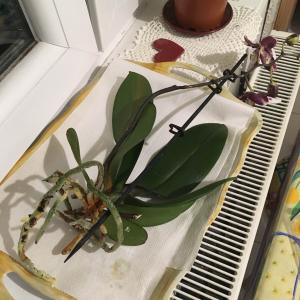

1
0
文章
Miss Chen
2018年05月01日

Description: This terrestrial orchid develops a single basal leaf during the fall that persists through the winter until the flowering period beginning in late spring. This basal leaf is 3½-8" long and 1-3" across; it is broadly elliptic or oblong-ovate in shape and smooth along the margins. The orientation of the basal leaf is ascending to horizontal with the ground. The upper leaf surface is dark green with fine white veins and glabrous; the veins are parallel to each other. The lower leaf surface is green, purplish green, or dull purple. At the base of the leaf, there is a short petiole that pokes above the ground surface. This basal leaf originates from the oldest corm of the root system. During the late spring or early summer, the basal leaf withers away and a raceme of flowers about 6-20" tall is sometimes produced. Each raceme will have about 8-16 flowers; they are laxly distributed along the flowering stalk. A large majority of plants fail to produce flowers during any given year, either because they are too small and immature, or environmental conditions are unfavorable.

The flowering stalk is pale green or pale purplish green, terete, and glabrous; it is surrounded by a tight basal sheath toward its base. The flowers are about ¾-1" long and a little less across, consisting of 3 sepals, 3 petals, and the reproductive organs; nectar spurs are lacking. The sepals spread outward from the center of the flower to a greater or lesser degree, and they are more or less equally spaced from each other. These sepals are narrowly oblanceolate or narrowly oblong, pale green or pale yellow, becoming purplish toward their tips. The two upper petals are narrowly oblanceolate or narrowly oblong and colored similarly to the sepals; these petals are adjacent to each other, functioning as a protective hood over the reproductive organs. The lower petal is the lip of the flower; it is oblanceolate or obovate and primarily white with speckles of purple or magenta. The lip is depressed in its center and its margins are elevated and undulate. The relatively stout pedicels of the flowers are about ¾" long, while the floral bracts are less than ¼" long and early-deciduous. The blooming period lasts about 2-3 weeks (late spring to early summer) and the flowers lack noticeable fragrance. In the absence of insect pollination, they are self-fertile. Afterwards, the flowers are replaced by seed capsules about ¾-1" long that are broadly ellipsoid in shape with multiple narrow ridges along their sides. These capsules nod downward from their pedicels along the raceme; later in the year, they split open to release abundant tiny seeds. These seeds are easily distributed to new areas via wind currents.
The root system consists of 1-4 bulbous corms that are connected by slender rhizomes. These corms are up to 1" across and individually they can persist for 2 years. On a healthy plant, a new corm is produced each year. Fibrous roots originate from the bases of the corms. Small colonies of clonal plants can develop from the spread of these corms.
Cultivation: The preference is dappled sunlight during the fall, winter, and spring; light levels during the summer are unimportant because live leaves are not present during this time of year. Significant photosynthesis can occur in temperatures that are only slightly above freezing. The root system of this orchid benefits from (and may require) a symbiotic relationship with compatible mycorrhizal fungi. Otherwise, this orchid may fail to flourish. It can be slowly propagated by separating its corms to establish new plants. Propagation by seed is very difficult and rarely successful. A moist to mesic loamy soil with abundant organic material is preferred. Soil pH can vary from mildly acidic to neutral.

Range & Habitat: The native Putty-Root Orchid is occasional toward the southern tip of Illinois, while in the rest of the state it is uncommon or absent (see Distribution Map). In spite of its lack of abundance, this is one of the more common orchids within the state. Habitats include rich mesic woodlands, wooded areas (e.g., terraces) above streams, damp depressions in upland rocky woodlands, the bottoms of sandstone canyons, areas near the bases of wooded slopes, and the bottoms or lower slopes of ravines. The Putty-Root Orchid is specifically adapted to deciduous woodlands where such canopy trees as Sugar Maple (Acer saccharum) and American Beech (Fagus grandifolia) are present. It is found in above average to high quality natural areas. Such invasive species as Garlic Mustard (Alliaria petiolata) and Japanese Stiltgrass (Microstegium vimineum) present a significant threat to maintaining populations of this orchid within the state should they continue to spread.
Faunal Associations: Various bees are likely pollinators of this orchid. A Halictid bee, Lasioglossum oblongum, has been observed visiting the flowers. Such insects are lured to this orchid's flowers by deception, as no nectar is present to reward such floral visitors. There is a potential risk of White-tailed Deer browsing on the flowering stalks and basal leaves, but more specific information about this is currently unavailable.
Photographic Location: A hilly woodland in east-central Illinois; the photographed orchid was located at the base of a wooded slope on a terrace above a stream.
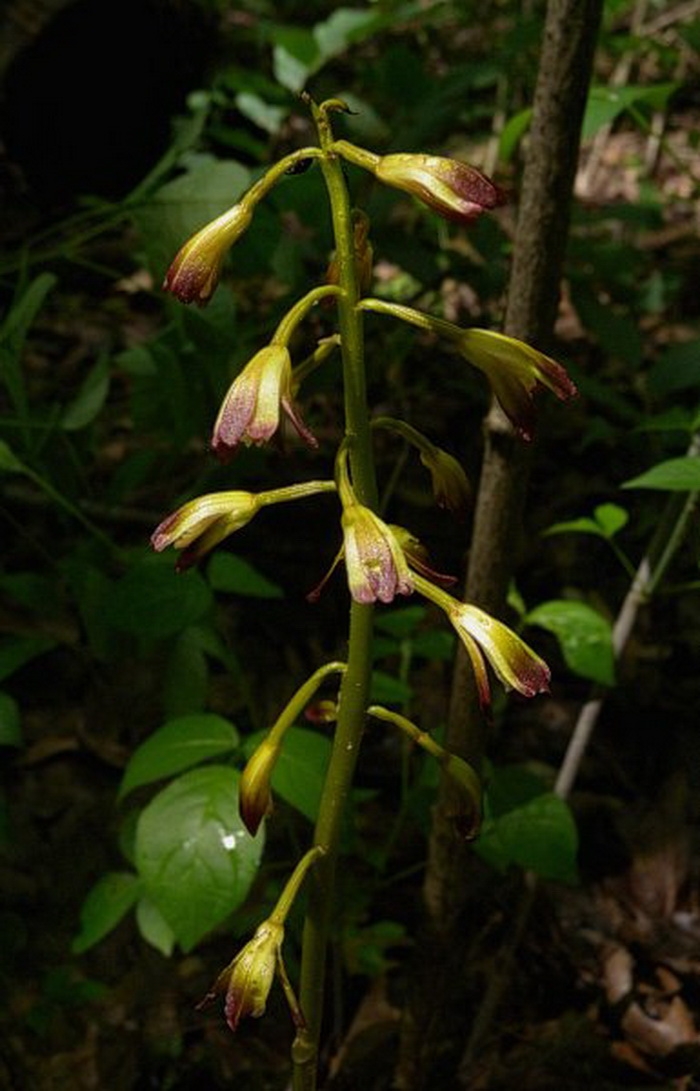
Comments: The flowers of this orchid are reasonably attractive, although their muted colors can make them difficult to spot in a woodland. The basal leaf is also attractive, which persists during the winter while disappearing during the summer! This odd characteristic takes advantage of the greater amount of light that is available when deciduous trees are leafless. In the past, a mucilaginous substance was obtained from the bulb-like corms that could be used to repair pottery and crockery, hence the name 'Putty-Root.' Another common name of this orchid is 'Adam-and-Eve,' which refers to the pair of corms that are connected together by a slender rhizome in the root system. The range of the Putty-Root Orchid partially overlaps a similar species, the Cranefly Orchid (Tipularia discolor), and it is possible to confuse these two species. The flowers of Putty-Root Orchid lack nectar spurs, while the flowers of Cranefly Orchid have nectar spurs that are long and slender. The racemes of the latter orchid tend to have more flowers (12-30) and these flowers are more white than those of the Putty-Root Orchid. There are also differences in the appearance of their basal leaves. The basal leaf of Putty-Root Orchid has white veins on a dark green background, while the basal leaf of Cranefly Orchid lacks white veins. The basal leaf of this latter orchid is also shaped differently (a little shorter and more wide) and its underside is usually a deeper shade of purple.

The flowering stalk is pale green or pale purplish green, terete, and glabrous; it is surrounded by a tight basal sheath toward its base. The flowers are about ¾-1" long and a little less across, consisting of 3 sepals, 3 petals, and the reproductive organs; nectar spurs are lacking. The sepals spread outward from the center of the flower to a greater or lesser degree, and they are more or less equally spaced from each other. These sepals are narrowly oblanceolate or narrowly oblong, pale green or pale yellow, becoming purplish toward their tips. The two upper petals are narrowly oblanceolate or narrowly oblong and colored similarly to the sepals; these petals are adjacent to each other, functioning as a protective hood over the reproductive organs. The lower petal is the lip of the flower; it is oblanceolate or obovate and primarily white with speckles of purple or magenta. The lip is depressed in its center and its margins are elevated and undulate. The relatively stout pedicels of the flowers are about ¾" long, while the floral bracts are less than ¼" long and early-deciduous. The blooming period lasts about 2-3 weeks (late spring to early summer) and the flowers lack noticeable fragrance. In the absence of insect pollination, they are self-fertile. Afterwards, the flowers are replaced by seed capsules about ¾-1" long that are broadly ellipsoid in shape with multiple narrow ridges along their sides. These capsules nod downward from their pedicels along the raceme; later in the year, they split open to release abundant tiny seeds. These seeds are easily distributed to new areas via wind currents.
The root system consists of 1-4 bulbous corms that are connected by slender rhizomes. These corms are up to 1" across and individually they can persist for 2 years. On a healthy plant, a new corm is produced each year. Fibrous roots originate from the bases of the corms. Small colonies of clonal plants can develop from the spread of these corms.
Cultivation: The preference is dappled sunlight during the fall, winter, and spring; light levels during the summer are unimportant because live leaves are not present during this time of year. Significant photosynthesis can occur in temperatures that are only slightly above freezing. The root system of this orchid benefits from (and may require) a symbiotic relationship with compatible mycorrhizal fungi. Otherwise, this orchid may fail to flourish. It can be slowly propagated by separating its corms to establish new plants. Propagation by seed is very difficult and rarely successful. A moist to mesic loamy soil with abundant organic material is preferred. Soil pH can vary from mildly acidic to neutral.

Range & Habitat: The native Putty-Root Orchid is occasional toward the southern tip of Illinois, while in the rest of the state it is uncommon or absent (see Distribution Map). In spite of its lack of abundance, this is one of the more common orchids within the state. Habitats include rich mesic woodlands, wooded areas (e.g., terraces) above streams, damp depressions in upland rocky woodlands, the bottoms of sandstone canyons, areas near the bases of wooded slopes, and the bottoms or lower slopes of ravines. The Putty-Root Orchid is specifically adapted to deciduous woodlands where such canopy trees as Sugar Maple (Acer saccharum) and American Beech (Fagus grandifolia) are present. It is found in above average to high quality natural areas. Such invasive species as Garlic Mustard (Alliaria petiolata) and Japanese Stiltgrass (Microstegium vimineum) present a significant threat to maintaining populations of this orchid within the state should they continue to spread.
Faunal Associations: Various bees are likely pollinators of this orchid. A Halictid bee, Lasioglossum oblongum, has been observed visiting the flowers. Such insects are lured to this orchid's flowers by deception, as no nectar is present to reward such floral visitors. There is a potential risk of White-tailed Deer browsing on the flowering stalks and basal leaves, but more specific information about this is currently unavailable.
Photographic Location: A hilly woodland in east-central Illinois; the photographed orchid was located at the base of a wooded slope on a terrace above a stream.

Comments: The flowers of this orchid are reasonably attractive, although their muted colors can make them difficult to spot in a woodland. The basal leaf is also attractive, which persists during the winter while disappearing during the summer! This odd characteristic takes advantage of the greater amount of light that is available when deciduous trees are leafless. In the past, a mucilaginous substance was obtained from the bulb-like corms that could be used to repair pottery and crockery, hence the name 'Putty-Root.' Another common name of this orchid is 'Adam-and-Eve,' which refers to the pair of corms that are connected together by a slender rhizome in the root system. The range of the Putty-Root Orchid partially overlaps a similar species, the Cranefly Orchid (Tipularia discolor), and it is possible to confuse these two species. The flowers of Putty-Root Orchid lack nectar spurs, while the flowers of Cranefly Orchid have nectar spurs that are long and slender. The racemes of the latter orchid tend to have more flowers (12-30) and these flowers are more white than those of the Putty-Root Orchid. There are also differences in the appearance of their basal leaves. The basal leaf of Putty-Root Orchid has white veins on a dark green background, while the basal leaf of Cranefly Orchid lacks white veins. The basal leaf of this latter orchid is also shaped differently (a little shorter and more wide) and its underside is usually a deeper shade of purple.
0
0


